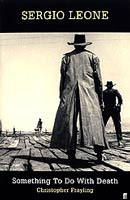Spaghetti recipe
John Cooper reads Christopher Frayling’s biography of legendary film director Sergio Leone and finds lessons for anyone in a creative discipline.

Every on-screen titles designer should watch the opening scene of Sergio Leone’s seminal western, Once upon a time in the West.
Three hard-bitten frontiersmen wait interminably at a desolate train station, surrounded by the arid plains of the US midwest.
Genre veteran Woody Strode stands beneath a dripping water tank, liquid collecting in his hat. When the train arrives, Strode takes his hat off and drinks the water. A grin spreads across his face; his thirst is quenched.
The titles are interspersed with the scene. The fonts, squashed serifs, slide majestically on to the screen. There is virtually no music, even though the great Ennio Morricone wrote the score, only the sound of flies buzzing and wind blowing around the station.
The sequence is classic. As the men wait, and the titles drift, tension builds. From the titles alone you can tell this film will be violent, pessimistic and highly stylised. It tells us much about the film; and is as good as anything by Saul Bass or Kyle Cooper. It is a masterpiece of understated minimalism.
Sergio Leone cared deeply about every detail of his films. It is therefore fitting that Christopher Frayling, who is poised to take up his post as chairman of the Design Council, has tackled the director’s biography. At just under 500 pages, the book is an exhaustive account of Leone’s career.
The first 100 pages are dedicated to a 13 year apprenticeship. Leone was lucky enough to work on the incredible chariot race in William Wyler’s epic Ben Hur, but mostly, he worked on what Clint Eastwood described as “a couple of toga movies”.
Frayling bombards the reader with the smallest details and background. When you finally reach chapter five, entitled Fistful of Dollars, you sigh with relief. Now Frayling can sink his teeth into more interesting subject matter. Leone certainly paid his dues, and the reader should know about it, but to go into that much detail before mentioning the director’s spaghetti westerns is excessive.
However, Frayling’s book starts firing on all cylinders (or do I mean with both barrels?) when he starts writing about these films.
A Fistful of Dollars was a remake of Akira Kurosawa’s Yojimbo, which itself was an adaptation of Dashiell Hammett’s Red Harvest, but Leone made the film feel fresh. A combination of his direction, Eastwood’s laconic performance, Jack Dalmas’ photography and Morricone’s score produced a masterpiece to ressurrect the western.
It also set a precedent for all Leone’s westerns: the director would take the classic work of US directors such as Robert Aldrich, John Ford, Howard Hawks and Budd Boetticher and reinvigorate them. Filming in lush, widescreen Techniscope formats (which dictated the style of the unique, eagle-eye close-ups) he created “fairy tales for adults”: darker, funnier and more pessimistic than the work of someone like Ford, and showed the west more like it really was.
Leone never learned English, but his knowledge of US history was impressive. The result was a land where everyone was corrupt, and the heroes had to behave amorally just to survive. Leone set the scene for greats like Sam Peckinpah, as well as not-so-greats like Quentin Tarantino.
There is a lesson to learn for anyone in a creative position. If you’re going to borrow someone else’s work, don’t just copy and paste. Think about it, add a lyrical quality, a touch of realism and think about whether you agree with the vision of the original. That way you might approach the stature of someone like Leone. In his day they called it neo-realism: “the authentic when it is filtered through imagination, myth, mystery and poetry” in Leone’s own words. Nowadays it is the difference between postmodern and rip-off.
Something to do with Death by Christopher Frayling is published by Faber and Faber on 6 March, priced £20
-
Post a comment



